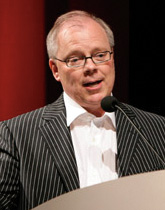In just a few minutes, the lights will come on, the cameras will roll, and all of his planning will come together. After almost 40 years in the business, it’s still surreal to actually see his work come to life. And it’s all come down to one moment. This moment.

John Shaffner (A’76) smiles as he remembers another “moment” in his life. He recalls being behind the steering wheel of a 1965 Thunderbird convertible. The year was 1979, and he was really doing it—leaving New York City for Hollywood. As he navigated through the bumper-to-bumper traffic with Broadway soundtracks blasting throughout the car, everything that led to that point flashed before his eyes: the many high school plays; his semesters at Macalester College in St. Paul, Minn., and the University of Montana; and finally his years at Carnegie Mellon. He shook his head in amazement while stealing a glance toward the man riding shotgun. Joe Stewart (A’77) turned and smiled at Shaffner. In the backseat Daniel Orlandi (A’76) smiled, too.
Shaffner is jerked back to the present when the set decorator runs up to him with a last-minute question. It’s funny, though, how the mind works. The decorator reminds him of his University of Montana stage design professor, Glenn Gauer (A’73), who first encouraged him to attend graduate school at Carnegie Mellon. That was another huge “moment,” as Shaffner followed his professor’s advice.
In one of Shaffner’s first classes at Carnegie Mellon, the professor asked whether any of the students had computer skills to work on a computer-aided design project that would be presented at a United States Institute for Theater Technology conference. Only Shaffner and one other student, Stewart, volunteered. The duo worked for many, many hours to create a computerized set/stage project. The work was examined by a number of scenographers (the European title for stage designer) at the 1975 conference. The scenographers told the two students that they had “an amusing little idea” but that the computers wouldn’t have relevance in the future for stage design.
The critique didn’t discourage Shaffner or Stewart. Good thing. Today, almost every set and stage design is done with the aid of a computer, and—not surprisingly—Shaffner and Stewart are considered by many in the design field as the pioneers.
Shaffner is again shaken out of his reverie. The lights are on, the cast walks onto the studio set, and the cameras begin to roll for another taping of The Big Bang Theory, a television sitcom that centers on two bungling physics students who live across the hall from a beautiful waitress.
The primetime show—one of three in which Shaffner and Stewart are production designers—serves as a weekly reminder to Shaffner of his time at Carnegie Mellon. Not that he isn’t regularly reminded in other ways, including, he says with a chuckle, often hearing the “Carnegie Mellon Mafia” reference used by “outsiders” when they affectionately talk about the expansive Carnegie Mellon–Hollywood alumni base. Shaffner adds to the “mafia” presence not only through the partnership of Production Design by Shaffner/Stewart, but also as chair and CEO of the Academy of Television Arts and Sciences, which makes him ex-officio trustee of the American Film Institute.
“Every time you turn around, there’s someone who graduated from Carnegie Mellon,” he says. The constant reminders are far from irritating to the former Alumni Merit Award winner. “I think one of the things I so appreciated about Carnegie Mellon is that it was a place where your time there is very intimate,” he recalls. “You really grow together in a way that I don’t know you can experience at a big university. I’ve seen this with other classes as well; they just clump together. And they clump through life together. Clump. Clump. Clump.” For Shaffner, a big part of that clumping has been with Stewart, who is his partner professionally and personally.
As The Big Bang Theory episode wraps and the studio closes down, Shaffner thinks about his journey: from the New York Shakespeare Festival in Manhattan in the summer of 1978 to the illusionist David Copperfield’s specials; from not only designing but also naming Star Search to the series Friends; from designing sets for Celine Dion and Willie Nelson to designing the American Music Awards; and, of course, from Shaffner/Stewart’s four Emmys, two Daytime Emmys, and one Art Directors Guild Award to being in charge of this year’s Emmy Awards, which recognize excellence in television programming.
His career path from New York to Hollywood overwhelms him at times. “Sometimes, I really can’t believe I’m the lucky person who gets to read the script before anybody else,” he says, while the bustle of the wrap-up takes place. So many people ask me, ‘So what do you DO exactly?’”
While he explains it’s hard to come up with a truly succinct answer, his essential job as production designer is to imagine what the show will look like, work in a collaborative process with the other people who also have ideas, and somehow take it through your brain and instruct a number of people how to make it all real. It’s that collaborative process that he credits for really inspiring him. “It’s wonderful to be able to have across-the-board interaction with all these people, everyone involved, who care so deeply that the project that we’re all working on is a success. I find that consistently amazing.”
It’s the best way, he adds, to create a moment.
Laurel Bosshart, a former newspaper reporter, is the assistant director of alumni communications. She is a regular contributor to this department.



